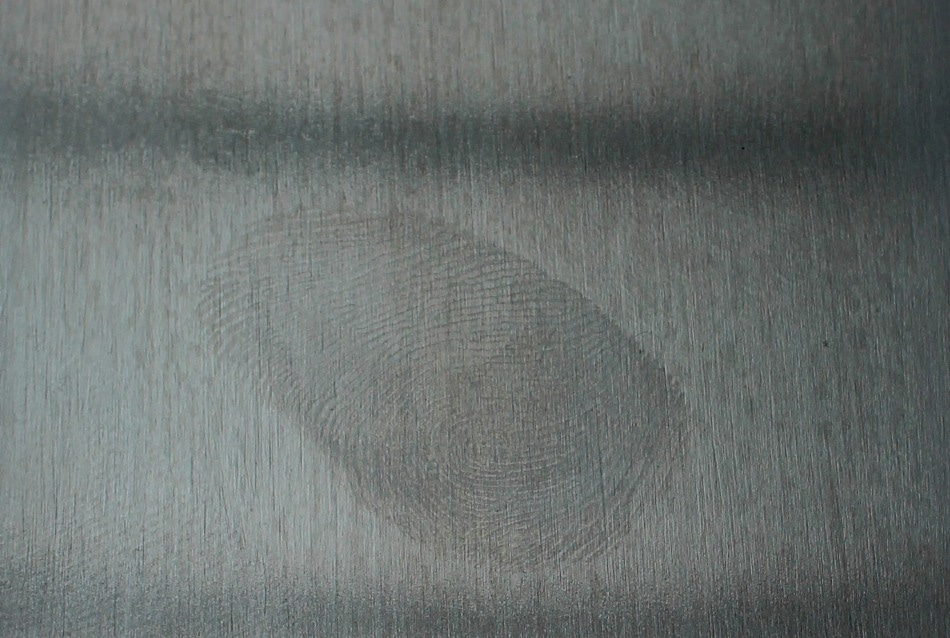Jul 2 2019
Greasy fingerprints on shiny stainless steel surfaces are not only unattractive but also have a negative impact on the particular surface. A new nanocoating that is being created by Fraunhofer scientists will soon prevent the annoying blotches that happen when fingers touch stainless steel surfaces. The key factor to their method: special nanoparticles incorporated to the coating.
 The new sol/gel nanocoating is designed to prevent fingerprints on stainless steel and metal surfaces. (©Fraunhofer IMWS)
The new sol/gel nanocoating is designed to prevent fingerprints on stainless steel and metal surfaces. (©Fraunhofer IMWS)
The shiny new refrigerator comprises an appealing stainless steel front. However, it does not take long before the door is smudged in dark fingerprints that are hard to remove with just a cloth and detergent; the job really requires some strenuous polishing. Fingerprints like these are more than just unattractive; the grease film also harms the metal surface.
Say goodbye to greasy smears
Along with their colleagues at FEW Chemicals GmbH in Wolfen, scientists from the Fraunhofer Institute for Microstructure of Materials and Systems IMWS in Halle are currently working to solve this issue of greasy smudges. A coating layer comprising special additives is the secret and this layer is oil and water repellent. The effects of the layer are twofold: When the particles integrated into the coating settle on the surface of the stainless steel, the surface becomes rougher and its surface area expands.
When a finger makes contact with the refrigerator door, it merely touches the surface’s raised points and the grease on the fingertip never reaches the “valleys” of the stainless steel surface. This means the surface area which actually makes contact with the grease is kept very small. Furthermore, the refractive index of the coating has been tweaked so that it matches that of the skin’s natural oil content. This means the coated stainless steel surface reflects light in quite the same manner as by a surface that has been touched by sticky fingers. Consequently, the fingerprints are barely noticeable.
Analysis of the layer systems
While FEW Chemicals GmbH is managing the development of the coating systems, the Fraunhofer researchers are focused on the analysis of these layers.
We’re investigating the layers created using not only optical microscopy, but also scanning electron microscopy and atomic force microscopy. We look at how large the individual particles in the coating system are and whether or not they are distributed homogeneously. The effect of the additives used is another focus of our analysis.
Dr. Jessica Klehm, Research Associate, Biological and Macromolecular Materials, Fraunhofer IMWS
Such queries are very vital in the assessment of the coating quality. For instance, if the nanoparticles aggregate to develop larger particles, the coating may lose its transparency consequently. Conversely, if the particles are very tiny, the surface remains very smooth, and the grease film sticks to it over larger areas despite the coating.
A number of challenges had to be handled before these examinations could be carried out. Primarily, the samples had to be reduced in size. Ideal investigations with optical microscopy as well as additional examination with other approaches necessitate that the samples have a thickness of no more than 60 to 80 µm, that is, about the thickness of a human hair; investigation under a transmission electron microscope even requires a sample that is one thousand times thinner.
We can’t cut the samples to size using a saw, which would destroy the coating. Therefore we embed the samples in resin and then grind them down to the desired thickness.
Dr. Jessica Klehm, Research Associate, Biological and Macromolecular Materials, Fraunhofer IMWS
Automatic testing machine quantifies anti-fingerprint effect
Additionally, the scientists are creating an automatic testing machine for the layers. The device is not meant to examine the particles in the coating, but instead the visibility of the fingerprints themselves. The machine immerses a stamp in a solution whose composition resembles that of the oily layer on human skin. Functioning automatically and with continually identical force and duration, this stamp then presses on the coated surface so as to leave “fingerprints” behind. The machine will use a mix of optical and spectrometric processes to examine how much of the solution stays on the surface and therefore to reach a percent value representing the anti-fingerprint effect of the coating. The researchers are presently working to identify the perfect blend of analytical equipment for the purpose.
The scientists have already identified a preferred one among the many coating systems they have tested. The task at hand is to further enhance the system. Development activities are scheduled to be completed by the end of 2020 when the mass-scale production of the coating system will be handed over to FEW Chemicals GmbH.
Source: https://www.fraunhofer.de/en